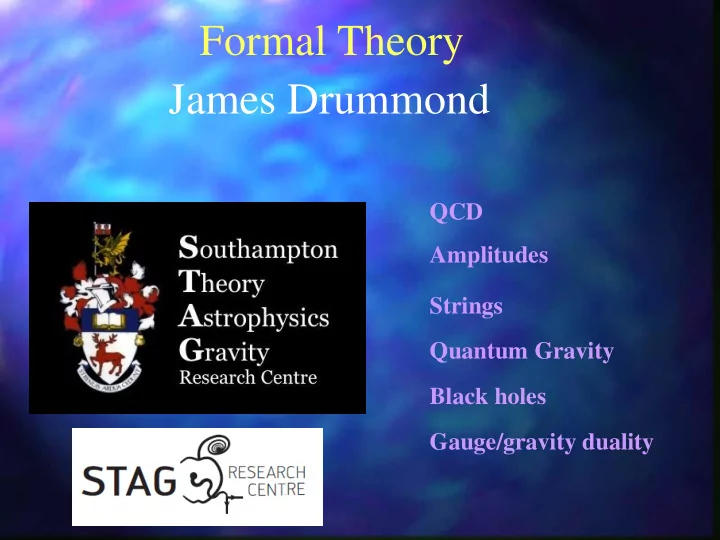

Formal Theory James Drummond QCD Amplitudes Strings Quantum Gravity Black holes Gauge/gravity duality
Marika Kostas Taylor Skenderis Nick Evans Tim Morris Masanori Hanada Carlos Oscar Andreas Mafra Dias Schmitt David Turton Ines Aniceto James Drummond Andy O’Bannon
Will we see something from the LHC to alter our view of the Standard Model of Particle Physics? What about the standard model of Cosmology? What are formal theorists up to? Answer: what they should be doing! * Understanding field theory, the structure that underlies the SM * Understanding strongly coupled systems, e.g. QCD * Thinking about (quantum) gravity – black holes – information? * Cosmology – inflation – dark energy?
Quantum Field Theory Weak coupling: perturbative approaches Scattering amplitudes – cross-sections What does Standard Model predict? What about strongly coupled systems? Gravity? Is QFT part of a bigger picture?
QCD Quarks Gluon mediated interactions SU(3) gauge invariance High energies: Asymptotic freedom Low energies: Confinement Dynamical mass generation m = 3 m / p u,d
Quantum Gravity R is a function of g mn and 2 derivatives This is a non- renormalizable theory…
New physics such as the string length sets in at the Planck scale (or before) Asymptotic safety – a non-perturbative UV fixed point emerges? Can such a theory need address dark energy problem…?
suggests String Theory string theory We need: supersymmetry 9+1 dimensions membranes graviton A candidate framework to include gauge theory and gravity Fundamental strings BUT.. Only understood perturbatively… and not Basic property is Tension directly linked to the SM…
Black Holes General Relativity predicts black holes… Pure states dropped into a black hole are re- emitted as thermal Hawking radiation… ‘tHooft argued that any • lost (breaking QM) information dropped into a • spread over the surface (S ~ A) black hole must be If the surface can contain all the information of the contents the real theory of the Universe must be 2 + 1 dimensional! HOLOGRAPHY
Gauge/Gravity Duality We now know this IS a string theory but in higher dimensions than QCD! N=4 SYM = IIB strings on AdS_5 Couplings such as g or UV Tr F^2 are scalar fields in this bulk… Remarkably those fields IR are weakly coupled in some cases when the gauge theory is strongly String theory/quantum gravity are coupled… holographically emergent phenomena…
Gauge/Gravity Duality Applications • QCD confinement, mass generation, spectrum • Deep inelastic scattering, hadronization… • Quark gluon plasma – heavy ion collisions… • Inflation • Strongly coupled condensed matter – graphene, high Tc super conductors, Kondo effect.. • Models potentially exactly solvable for finite coupling (e.g. N=4) . Analogue of QCD spectrum. • Duality of amplitudes/Wilson loops. • Non-perturbative definition of strings • Black holes - information • New window on quantum gravity from CFT • The Big Bang singularity - inflation
New formulations of QFT? New symmetries On-shell methods Analytic structure of S-matrix Revisiting UV of gravity Resumming perturbation theory
Marika Kostas Taylor Skenderis Nick Evans Tim Morris Masanori Hanada Oscar Andreas David Turton Dias Schmitt Carlos Ines Aniceto James Drummond Andy O’Bannon Mafra
Fundamentals of Black holes, strings/holography holography cosmology Holography ERG QCD, BSM AS & QG Numerical AdS/CFT Black holes and Black holes QCD & neutron AdS/CFT stars Integrability and CFT & string amplitudes Amplitudes, CFT, Holography & CM resurgence Integrability
STAG Lunch Group: Tuesday 1pm STAG Seminar: Wednesday 1pm Gravity seminar: Thursday noon STAG also includes the classical GR group in Maths: neutron star structure, compact object collisions and merger, numerical GR. Astrophysics group: observation and modelling of compact objects and gas inflow
Recommend
More recommend